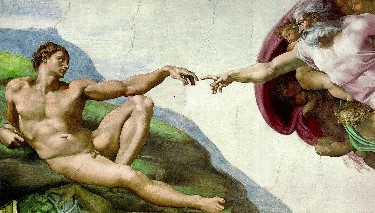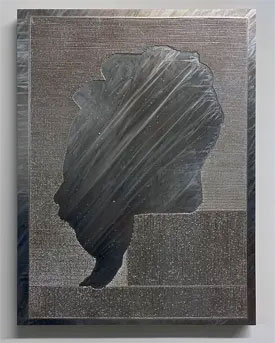Stepping Up to Michelangelo
John Haberin New York City
Up Close: Michelangelo's Sistine Chapel
Andrew Witkin After Michelangelo
It was never easy to take in the Sistine Chapel. Michelangelo himself labored on scaffolding of his own design, while struggling to reach the figures still taking shape overhead.
It may be harder still today. It means braving the lines and craning one's neck to see the ceiling, around crowds as never before. Imagine, then, Pope Julius II joining the artist for a closer look. Forget the scenery chewing of The Agony and the Ecstasy, the 1965 movie with Charlton Heston as the artist and Rex Harrison as the pope. Julius (in between complaining about the artist's slow pace) visited often, stepping up from a ladder, and Michelangelo (in between complaining about his loss of secrecy) lent a hand.  For a while, though, New Yorkers could put themselves in his place, without so much as a ladder or a trip to Rome.
For a while, though, New Yorkers could put themselves in his place, without so much as a ladder or a trip to Rome.
"Up Close: Michelangelo's Sistine Chapel" brought thirty-four photographs to the World Trade Center PATH station—on their way to a second showing at the Garden State Plaza in New Jersey. Maybe, just maybe, it brought with it a closer approach to the art. Still not close enough? Andrew Witkin lines a wall with images, so that there is no craning your head, but also no dispelling the mystery. On August 14, 1511, as the Sistine Chapel once again welcomed congregants to Mass, the ancestors of Jesus were conspicuously absent. So they are again with Witkin, but you may think you see them in their silvery shadows.
Even now, with so much else to see, visitors to the Sistine Chapel might never notice the ancestors. As Howard Hibbard notes, they are also among the hardest spots to see. They are missing once again today in etched magnesium. Witkin wanted to remove distractions, whether visual or in the ceiling's details and history. Perhaps he hesitated to compete with Michelangelo as well. Yet their majesty and motion shine through in their absence—in the depicted stone on which they sat and in their silhouettes.
Behind locked doors
Instead of locked doors, the PATH Oculus presented the obstacles of hype, an upscale shopping mall, and a healthy admissions price, but one could choose not to pay it. A walk around the mezzanine took one close to the upper registers of The Last Judgment, much like the view of a two-story painting by Cristóbal de Villalpando at the Met. A walk round the perimeters of the lower level filled in the gaps. With decent enough eyesight, one could even read much of the accompanying text. Besides, even at a distance one can appreciate the unfolding drama of the Sistine Ceiling. One can appreciate, too, broad areas of highlights on blue, red, orange, and naked flesh.
Michelangelo thrived on obstacles. Misanthropic as ever, he banished assistants and started again after the first of his frescoes began to mold, and he executed them his way—transferring full-scale drawings, or cartoons, with a stylus. In the process, he created an ideal of the artist as stubborn, lone creator that endures to this day (although dissenting scholars argue that he retained assistants throughout, if only in an undetermined lesser role). He thought of himself only reluctantly as a painter, which may be why he put off the pope's first request, for paintings of the twelve apostles. They would be poor work, he explained, because the apostles were poor as well. The pope, he later wrote, replied that he could paint what he liked (so long, presumably, as he liked the Church's program), and off he went.
That, too, presents an obstacle. Even scholars have trouble making sense of the scheme—which includes prophets and oak leaves (from the pope's own family crest) along the edges, ancestors of Jesus in the lunettes between them, violent acts from the Hebrew Bible and rams' heads in the corners, and the great scenes from Genesis down the middle. (Michelangelo removed a section or two in order to add The Last Judgment many years later.) The opportunity to get close adds its own difficulties. One cannot see the ceiling's architecture as a whole, in all its colliding messages and rhythmic borders. One has not a hint of other frescoes either, by such leading lights of the early Renaissance as Pietro Perugino and Domenico Ghirlandaio, on the chapel's walls.
One can never forget, too, that one is looking at reproductions. Erich Lessing's photos stand in arbitrary groupings, on the sides of blocks on the floor. They even resemble magazine spreads in their pairing of text and image on the same surface. Instead of the ceiling's tunnel vision ending in the chaos of an early universe, they also present something of a maze. For all that, they have their advantages, even apart from the chance to get close. They combine the resolution and luminosity of contemporary prints with the depth and luminosity of paint.
As a painter, Michelangelo had a lot to learn as he took the Renaissance into a new century. More and more in the course of things, figures fill the frames. The prophets take on bulkier forms, sharper and even terrifying features, and more pronounced gestures beyond the picture plane, while the ancestors of Jesus withdraw into a greater anxiety. That leaves the proverbial agony and ecstasy of Adam, Eve, and their god in the trademark scenes of creation and expulsion. More and more, too, they display the sweeping brushwork of a real painter, with a translucency rare in fresco. Italian art restorers tend to overclean by American standards, but they have shown Michelangelo as a bold colorist capable of reaching out to his viewers—suiting that view from a distance.
After Michelangelo after all
Michelangelo had kept a remarkable pace nearing the end of what is still the most celebrated project in western art—not just the scenes like the creation of Adam on the Sistine Ceiling, but also the prophets and nudes bridging the ceiling, the windows, and the walls. He had been laboring for five years, but more work lay ahead. He took down his scaffolding at last, so that Pope Julius could celebrate Mass and the Assumption of the Virgin. The rites completed, he set up lighter, more movable scaffolding to wrap up the lunettes, that awkward space above the windows. The familiar architectural element takes its name from their shape, like the crescent of the moon. Additional ancestors turn up elsewhere on the ceiling as well, with a lonely virtue prefiguring their absence.
The ancestors may get passed over often as not, but Michelangelo did not lack for fame in his lifetime. His David alone assured that, as a standing nude and as a symbol of Florence's independence. The ancestors, too, found a ready audience, in thirty-two prints from around the time of his death in 1564.  Adamo Scultori, the printmaker, had the added cachet of working not from the frescoes one sees today but from drawings, by Michelangelo or a follower. I shall guess the former, given an artist who did not work well with others. He did fire his assistants, lock the doors, and start over with the Sistine Ceiling, with Raphael working and waiting just outside.
Adamo Scultori, the printmaker, had the added cachet of working not from the frescoes one sees today but from drawings, by Michelangelo or a follower. I shall guess the former, given an artist who did not work well with others. He did fire his assistants, lock the doors, and start over with the Sistine Ceiling, with Raphael working and waiting just outside.
Still, you never know, for the drawings have not survived. In any case, Witkin's plates are, proudly, copies after copies—and they omit their very subject. The burnished metal surfaces in their place could be what Jacques Derrida lauded as marks of erasure. Andrew Witkin, also a dealer, must know well the postmodern vocabulary. He calls the show "After (After Ancestors)." So much for the originality of the avant-garde.
Got all that? Nor does he proceed as an engraver would, from the plates to prints on paper. Still, mind games may not be so bad after all, not in trying to pin down a long-dead, troubled artist's mind. Besides, the metal shines. Scultori worked in dense parallel incisions, the cross-hatching of a trained draftsman—but not, as it happens, like Michelangelo drawings. Scultori's technique may count as mechanical compared to his and already dated, but Witkin turns vice into virtue.
Make that competing virtues. With magnesium rather than an engraver's copper, the shine ranges from dark gray to near white, while the visible cuts add to its energy and instability. And then come an uncut metal frame, its shadow on the wall, and the burnished omissions. Twenty-seven plates hang in three tight rows, unlike Michelangelo's spandrels and lunettes. The unseen figures seem to struggle against the original curved framing, much like the originals. They call attention to Michelangelo's musculature and motion in stillness.
Michelangelo did not play well with others either, and he may have counted the pope as his only male friend. Julius may increasingly have felt the same way. Hibbard, in his book on Michelangelo, attributes the languor of the ancestors, verging on sadness, to their role as precursors, neither here nor there. In 1511, though, as textbooks explain, the Vatican was losing its wars and bracing for an invasion. Dismiss the Sistine program as baggage, better off under erasure, but Michelangelo could not. One cannot separate its ambition from fears for what might survive.

"Up Close: Michelangelo's Sistine Chapel" ran at the Oculus of the World Trade Center transportation hub through July 23, 2017, and subsequently at the Westfield Garden State Plaza in Paramus, New Jersey, through October 15. Andrew Witkin ran at Theodore through April 6, 2024. Related reviews look at Michelangelo drawings and attributions.




